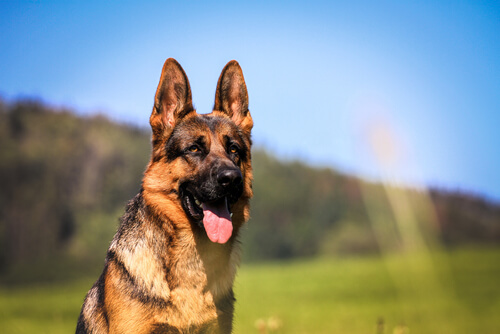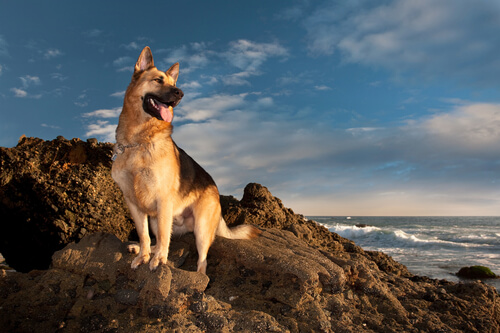Types of German Shepherd

All types of German Shepherd share the same qualities: they’re active, intelligent, and loyal companions. However, when naming this breed, the classic image of the dog with erect ears, brown and black hair and a drooping croup comes to mind, and nothing could be further from the truth.
There are several aspects of this dog that are internationally accepted and are worth knowing about. So, don’t miss any of the following. Let’s get started.
Characteristics of the German Shepherd
The German Shepherd is a breed created specifically to protect and guide flocks of sheep. Back in 1899, when it was defined, they were looking for a flexible, resistant, and muscular dog, which was also faithful and intelligent.
Precisely because of its faithfulness to its humans, it was also used as a watchdog.
It’s a large breed that can reach 65 centimeters (2.1 feet) in height and 40 kilograms (88 pounds) in weight. It’s a well-proportioned dog, with erect ears, a muscular back, and a hard and somewhat rough coat. The color of the coat ranges from black, brown and gray depending on the area of the body you look at.
During the 10-12 years of life expectancy of the German Shepherd, you’ll enjoy the company of a faithful, intelligent and energetic dog. It is necessary to provide them with a good dose of daily exercise, as well as correct and consistent training. Without the latter, the animal may end up becoming overprotective and distrustful of strangers.

Types of German Shepherd
Let’s get down to the nitty-gritty. Within this breed, there are several types that differ mainly in the color and length of the coat. Let’s take a closer look at them.
Panda German Shepherd
The coloring of this German Shepherd is very curious. Due to a genetic mutation, a dog with white patches on the neck, chest and face was obtained, which is where the name panda comes from. In addition, some of them also have blue eyes.
This gene can come from both the father and the mother and be passed on to the offspring.
Long-Haired German Shepherd
This is another of the most striking types of German Shepherd. Unlike the previous one, this one isn’t the product of chance, but of forced crossbreeding.
This dog shares all the morphological characteristics with the rest of its fellow species, but has a long and silkier coat. For this reason, you’ll need to look after their health carefully if you live in a hot place, as it’s more difficult for them to thermoregulate in high temperatures.
Dutch German Shepherds
This German shepherd dog followed a different path of modifications in the country that gives it its name. There it was made into a smaller dog, with darker colors and shorter hair. Apart from that, it’s still an energetic, muscular, and well-proportioned dog.
Black German Shepherds
In addition to the black color that covers its entire coat, these German Shepherds are also larger than others of their breed. It can have both long and short hair, as it’s a color resulting from artificial genetic selection.
White German Shepherds
This is one of the most appreciated types of German Shepherd because of its white coat and its smaller size. It’s also sought after for use in work in snowy environments, such as searching for people in caught up in natural disasters or herding in cold areas.
Dwarf German Shepherd
This variety of German Shepherd is the miniature version of the breed, crossed with other dogs to prevent the proper growth of its body. The result is a smaller dog than usual, with shorter legs and more mismatched proportions in terms of leg thickness and head size.
Sable German Shepherd
Another color variety found within the German Shepherds is the Sable, characterized by having a more grayish hue. In this darker coat, we can find some golden, brownish shades, and some white spots.
Different types of German Shepherd, the same character

Although this breed was created for herding and guarding, this can’t detract from the fact that many people choose it as a life companion. Their intelligence, loyalty, and high amount of energy make them ideal for those who enjoy outdoor exercise.
Their protective instinct is strong, hence the emphasis on socialization. They’re generally not very trusting of strangers and tend to develop behavioral problems due to lack of activity. So, if you decide to bring a German Shepherd into your life (whatever color it is), remember that the most important thing is to preserve their health and happiness.
All cited sources were thoroughly reviewed by our team to ensure their quality, reliability, currency, and validity. The bibliography of this article was considered reliable and of academic or scientific accuracy.
- DEUTSCHER SCHÄFERHUND. (s. f.). FCI. Recuperado 28 de julio de 2022, de https://www.fci.be/en/nomenclature/GERMAN-SHEPHERD-DOG-166.html
- Willis, M. B. (1991). The German Shepherd Dog: a genetic history. HF & G. Witherby Ltd.
- Chávez, G. A., & Opazo, Á. J. (2012). Predatory aggression in a German shepherd dog. Journal of Veterinary Behavior, 7(6), 386-389.
This text is provided for informational purposes only and does not replace consultation with a professional. If in doubt, consult your specialist.